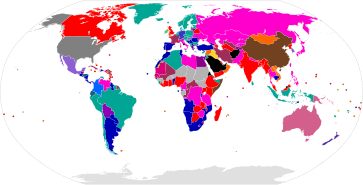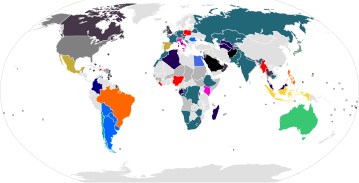
A | B | C | D | E | F | G | H | CH | I | J | K | L | M | N | O | P | Q | R | S | T | U | V | W | X | Y | Z | 0 | 1 | 2 | 3 | 4 | 5 | 6 | 7 | 8 | 9
This section needs additional citations for verification. (September 2014) |
| Part of the Politics series |
| Electoral systems |
|---|
 |
|
|
This is a list of electoral systems by country in alphabetical order. An electoral system is used to elect national legislatures and heads of state.
Maps
|
Single-winner system / single-member constituencies (non-proportional) First past the post/single member plurality (FPTP/SMP)
Two-round system (TRS)
Instant-runoff voting (IRV)
Multi-member constituencies, majoritarian (non-proportional) Block voting (BV) or mixed FPTP and BV
Party block voting (PBV) or mixed FPTP and PBV
Multi-member constituencies, semi-proportional Single non-transferable vote (SNTV) or mixed FPTP and SNTV
Modified Borda count
Multi-member constituencies, proportional Party-list proportional representation (list PR)
Single transferable vote (STV)
|
Mixed non-compensatory (semi-proportional) Mixed-member majoritarian (MMM): parallel voting (FPTP and list PR)
Mixed-member majoritarian (MMM): parallel voting (TRS and list PR)
Mixed-member majoritarian (MMM): parallel voting (BV/PBV and list PR)
List PR with plurality bonus (MBS)
Parallel voting (SNTV and list PR)
Mixed compensatory (proportional or semi-proportional) Mixed-member majoritarian (MMM) with compensation / scorporo
Additional member system / semi-proportional MMP
Majority jackpot (majority of seats reserved for largest party/coalition)
|
Indirect election Election by legislature
Election by electoral college or local legislatures
Partly elected by electoral college or local legislatures, partly appointed by head of state
Other No election (e.g. Monarchy)
Appointed by head of state
Varies by federal states or constituencies
No information/Unicameral legislature
|
Electoral systems by country
Key
Type of system
Type of representation:
Number of winners in a contest—whether single or multiple (more than one)
- single winner (single office at-large such as mayor, or chamber filled by single winner contests in districts dividing electorate. System used is usually one of FPTP, TRS, instant-runoff voting.
- multiple winners (block voting, STV, limited voting)
Type of electoral method
Type of elections
- direct elections
- indirect (by legislature(s) and/or electoral college),
- no election (chosen by a single person, or other rules e.g. hereditary)
Winning formula:
- majoritarian/plurality (body elected in winner-take-all districts e.g. FPTP, TRS, block voting),
- majoritarian (Instant-runoff voting, TRS),
- proportional (body elected by STV or party-list PR),
- semi-proportional (e.g. SNTV, LV).
Mixed systems use two or more of these methods, and produce chamber where different members are elected through two or more different election methods. (Mixed Member Proportional elects members through both first past the post and proportional.) Parallel voting systems, such as used in Egypt, are examples of mixed systems.
- Seats per district or contest
- Some elections fill all the seats in the chamber (Netherlands, Israel). Most times the electorate is split into a number of electoral districts where all the district members are elected at one time. In some elections, there is one person elected per district. In others, there are many people elected per district (sometimes all districts have same number of seats; other systems use districts with varying number of seats.) (Proportional representation and STV depends on use of a contest that fills multiple seats at one time.) Electoral districts can have different names, see list of electoral districts by nation. Some election systems see half or a third of the members elected at one time (staggered terms).:
Election systems can use one or more layers.
- First past the post elections use just one layer. : MMP (an example of a mixed system listed above) uses both district elections and overall pooling of votes, usually where voters cast both a district vote and a party vote. In Demark's mixed member system, a single vote is used both for election of the district member and of an at-large party seat.: Some city election systems, such as City of Thunder Bay (Canada) and Nelson (New Zealand), use both ward elections and at-large district to elect members of city council. At-large contests elect multiple members so make either list, PR, STV or block voting possible. As well, multi-member wards, such as used in Nelson, make either list PR, STV or block voting possible. Single-winner ward contests usually use the first past the post, instant-runoff voting or the two-round system.:
- Total number of seats
- the number of representatives elected to the body in total. (general rule is number of members in the lower house is the cube root of the total population.)[1]
- Electoral threshold
- see Electoral threshold
Type of vote used
First past the post uses single X voting.
Block voting uses multiple X voting, same as number of seats to fill.
STV and Instant-runoff voting use ranked votes.
List PR uses X voting.
Limited voting uses multiple X voting, not as many as number of seats to fill.
List
| Country | Body or office | Type of body or offices | Type of electoral system | Electoral system | Seats per district (if applicable) |
Total seats | Electoral threshold (if applicable) |
Notes | |
|---|---|---|---|---|---|---|---|---|---|
| Afghanistan | Supreme Leader of the Islamic Emirate | Head of State | election by unelected body | Elected by the Leadership Council through consensus[2][3][4] | Autocrat with life tenure[5] | ||||
| Albania | President of the Republic | Head of State | indirect | Elected by the Parliament through a secret vote.[6] | A three-fifths majority of all members in the first three rounds, absolute majority (50% +1 vote) in the next two rounds | If no candidate has attained the necessary majority in five rounds, the Parliament will be dissolved and a general election must occur within 60 days.[7] | |||
| Parliament (Kuvendi) | Unicameral legislature | proportional | Party list PR: Open lists, D'Hondt method[8] | 3–36 | 140[9] | 1% | |||
| Algeria | President of the People's Democratic Republic | Head of State | single winner | Two-round system[10] | |||||
| Council of the Nation | Upper chamber of legislature | indirect | Partly, indirect election (2/3), partly appointed by the president | 96 (indirect election), 48 (appointed) | 144 | ||||
| People's National Assembly | Lower chamber of legislature | proportional | Party list PR: Open lists, Largest remainder method (Hare quota)[10][11] | 5–37, 2 (districts representing people abroad)[citation needed] | 407[11] | 5% of votes in respective district[11] | Electoral districts correspond to wilayas (provinces) | ||
| Andorra | Co-Princes | Heads of State | no election | President of France (elected directly in France) and the Bishop of Urgell (appointed by the Holy See) | 2 | ||||
| General Council of the Valleys | Unicameral legislature | mixed | Parallel voting: party block voting (local) + list PR (nationwide) | 2 (local districts) / 14 (nationwide constituency) | 28 | ||||
| Angola | President | Head of State and Government | single winner | First-past-the-post between the top candidates on party lists for National Assembly elections | (Double simultaneous vote) | ||||
| National Assembly | Unicameral legislature | proportional | Party list PR: Closed lists, D'Hondt method | 5 per province, 130 across country, + 3 representatives from abroad | 233 | ||||
| Antigua and Barbuda | King | Head of State | no election | Hereditary monarchy | |||||
| Senate | Upper chamber of legislature | no election | Appointed by the Governor-General | 17 | On advice: 11 (Prime Minister), 4 (leader of the opposition), 1 (Barbuda Council); At discretion: 1 | ||||
| House of Representatives | Lower chamber of legislature | majoritarian | First-past-the-post | 1 | 17 | ||||
| Argentina | President | Head of State and Government | single winner | Modified Two-round system | To win in the 1st round, 45%, or 40% and a 10% lead over the second candidate is needed | ||||
| Senate | Upper chamber of legislature | semi-proportional | Limited voting with party-lists: 2 seats to most voted party or coalition in each province, 1 seat to second most voted party or coalition (limited vote with closed lists) | 3 | 72 | ||||
| Chamber of Deputies | Lower chamber of legislature | proportional | Party list PR: Closed lists, D'Hondt method | 5–70 (Renewed by halves) | 257 | 3% of registered voters | |||
| Armenia | President | Head of State | single winner | Since 2018, the President is elected by members of parliament. | |||||
| National Assembly | Unicameral legislature | proportional | Party list PR / optional runoff with majority jackpot or minority jackpot: Largest remainder. Nationwide Closed list and an Open list in each of 13 election districts. | at least 101 | 5% (parties), 7% (blocs) | Party lists run-off FPTP to ensure stable majority of 54% if it is not achieved either immediately or through building a coalition (majority jackpot) or a party wins more than 2/3 of seats (minority jackpot).[12][13] | |||
| Australia | King | Head of State | no election | Hereditary monarchy | |||||
| Senate | Upper chamber of legislature | proportional | Single transferable vote (STV) | 6 (12 per state, renewed by halves), 2 per territory [14] | 76 | In the event of a double dissolution, all 12 seats in each state are up for election. | |||
| House of Representatives | Lower chamber of legislature | majoritarian | Instant runoff voting (IRV) | 1 | 151 | ||||
| Austria | President | Head of State | single winner | Two-round system | |||||
| Federal Council (Bundesrat) | Upper chamber of legislature | indirect | Proportional to the distribution of seats in the state parliaments (indirect Party list PR) | 3–12 votes | 61 votes | ||||
| National Council (Nationalrat) | Lower chamber of legislature | proportional | Party list PR: Largest remainder (Hare quota) at district and regional levels, D'Hondt method for remaining votes at national level | 183 | 4% | ||||
| Azerbaijan | President of the Republic | Head of State | single winner
Zdroj:https://en.wikipedia.org?pojem=List_of_electoral_systems_by_country Text je dostupný za podmienok Creative Commons Attribution/Share-Alike License 3.0 Unported; prípadne za ďalších podmienok. Podrobnejšie informácie nájdete na stránke Podmienky použitia.
Analytika
Antropológia Aplikované vedy Bibliometria Dejiny vedy Encyklopédie Filozofia vedy Forenzné vedy Humanitné vedy Knižničná veda Kryogenika Kryptológia Kulturológia Literárna veda Medzidisciplinárne oblasti Metódy kvantitatívnej analýzy Metavedy Metodika Text je dostupný za podmienok Creative
Commons Attribution/Share-Alike License 3.0 Unported; prípadne za ďalších
podmienok. www.astronomia.sk | www.biologia.sk | www.botanika.sk | www.dejiny.sk | www.economy.sk | www.elektrotechnika.sk | www.estetika.sk | www.farmakologia.sk | www.filozofia.sk | Fyzika | www.futurologia.sk | www.genetika.sk | www.chemia.sk | www.lingvistika.sk | www.politologia.sk | www.psychologia.sk | www.sexuologia.sk | www.sociologia.sk | www.veda.sk I www.zoologia.sk | ||||||



